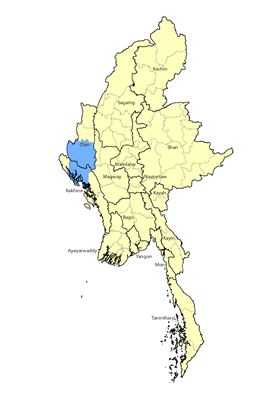The Letu have been recognized by the government in Myanmar for nearly a century, with the 1931 census returning 1,530 Letu people, all of whom were animists. This group, who are often called Laitu, is rare among the 61 Chin tribes in Myanmar in that most are Buddhists rather than Christians, and the majority live outside of Chin State. Several Letu subgroups may qualify as separate people groups with their own dialects and customs, including the 15,000 Doitu people.
Location: The 37,000 Letu people inhabit a sizeable area across five townships in southwest Myanmar. They are located “along the banks of the Lemro River and its tributaries north and south of Mrauk-U in Rakhine State and Chin State. Their villages range from a few houses to a few hundred houses and lie between the river and the mountains, both of which are considered important for their livelihood.”
Language: Linguists conducted a survey of the Letu areas in 2007 and found that all group members could speak their tribal language. Most can also speak the main regional language, Rakhine. There is significant diversity among Letu speakers, with eight dialects identified. The Doitu dialect is spoken by those living in the hills, while Lai and Laitu are two dialects used in the valleys. SIL noted: “Letu is somewhat intelligible with Sumtu, Uppu, and Songlai, but other factors block comprehension since they must use another language to communicate.”
Originally, the Letu were said to have been “warrior hill tribes who lived in small groups. They moved down to the banks of the Lemro River in the 4th century AD and began to live together in larger villages. Another source says the ancestors of the Letu “migrated from the Mon River and the Minbu District of Magway Region in 11 and 12 AD.”
Letu girls traditionally received face tattoos at puberty. The custom is said to have started after a Burmese king “was so impressed by a woman's beauty that he kidnapped her to take as a bride. Because of this, Letu families began to tattoo their daughters to ensure they would not be taken away.”Disaster struck the Letu area in November 2011, when all 567 permanent shops in the market area of Minbya Township were burned to the ground as a fire swept through the neighborhood. During the civil war in 2023 and 2024, the Burmese government lost control of the Mrauk-U District as it was taken over by the Rakhine Army.
The pattern of Letu women's face tattoos often resembles a spider web, with a circle within a square on the forehead and concentric lines covering the entire face. One source lamented: “The Letu people have lost much of their traditional culture, and the tattooed ladies are some of the last remaining visible cultural assets. The women are the last generation who will ever have these tattoos, which they received to mark their coming of age, given that the then military junta ruling the country banned them in 1976.”
After centuries of influence from the neighboring Rakhine people, more than half of Letu people continue to adhere to Buddhism today. An estimated 40 percent of Letu people are Christians, especially those living in southern Chin State, while the remainder still practice the animistic rituals of their forefathers, which predate the arrival of both Buddhism and Christianity.
It appears that no early missionary work was conducted in the Letu areas, with a 1917 book stating: “The unadministered territory has a population of at least 30,000. There has never been a missionary of any denomination among them.”When it was first suggested that a literacy program might benefit the members of the tribe, the Buddhist leaders strongly opposed the plan, as they were “suspicious of Letu literature and feared it was a ploy to convert them to Christianity.”Two groups are currently producing Bible translations, one in the Laitu dialect and the other in Doitu. In the absence of Scripture, preaching in Letu church services has typically been conducted in Burmese, with announcements made in Letu.
Scripture Prayers for the Letu in Myanmar (Burma).
| Profile Source: Asia Harvest |











